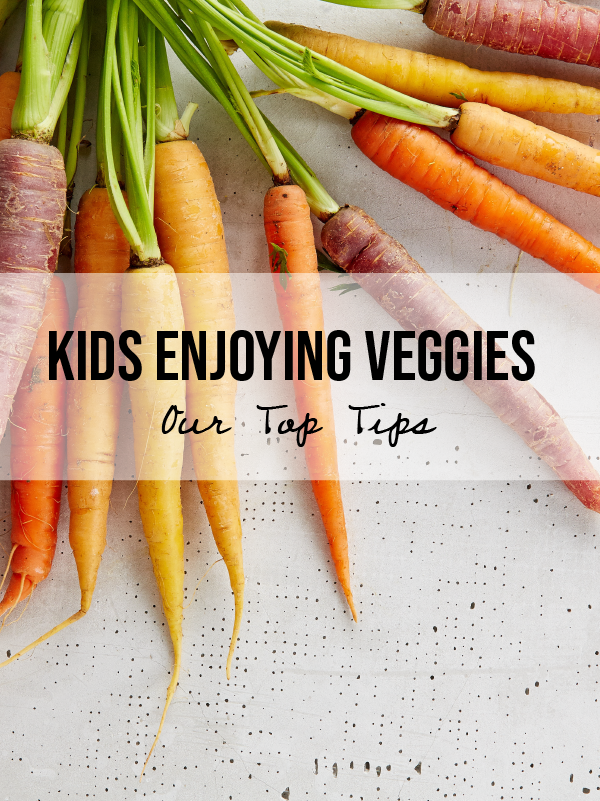We all know that vegetables are an essential part of a healthy diet, but getting children to eat vegetables, or enough of them is where things get challenging for many parents. Most parents start off with the best intentions, but as hard as we try, getting vegetables into children is not always as easy as it sounds and often leaves parents feeling frustrated and disheartened at the dinner table. Whether it’s picking out tiny chunks of carrots from a spaghetti bolognese or completely refusing to even touch anything green, there is a broad spectrum of fussy eating and some children will be more difficult than others to convince.

Childhood Vegetable Intake in Australia
The latest nationwide studies show that in 2014-2015 only 5% of children ate the recommended serves of vegetables per day. Aside from the obvious lack of vegetables for most children (and therefore essential nutrients), what is concerning about this data is that this period of childhood is a time in which lifelong healthy eating behaviours can be developed and carried through to adulthood.
It is important that parents prioritise the intake of vegetables to create positive habits to set their child up for a happy and healthy life.
So, how many vegetables should your child be consuming? The current Australian dietary guidelines from the National Health and Medical Research Council recommend the following intakes by age:
- 1-2 years should have 2-3 serves of vegetables each day
- 2-3 years should have 2½ serves of vegetables each day
- 3-12 years should have 4½ serves of vegetables each day
1 serve = 1/2 cup vegetables, 1 cup of salad greens or 1/2 beans or legumes.

Food Neophobia vs Likes and Dislikes
Food neophobia is the term used to describe the initial rejection of foods, and this usually peaks for most children around age 2-3 years. Whereas food aversions or ‘liking’ refers to the tendency to associate either positive or negative consequences of eating the food with the food itself.
Here are our recommendations to reduce and overcome food neophobia and aversions to help you increase your child’s vegetable intake.:
1: Early Exposure To A Variety Of Foods
Early repeated exposure to a variety of flavours can lead to greater acceptance of new foods in later life. Introduce your baby to as many different vegetables when you start weaning. If a child rejects a food initially, don’t give up! Try to mix that food in with another food, gradually increasing the intensity of the flavour they did not like or try attempting to give similar tasting foods. Additionally, acquiring a liking for a certain food tends to take longer than acquiring disliking for a certain food, so repeated positive exposures are required to enhance the liking of a food.
2: Start With Bitter Foods
We have an innate preference for sweet-tasting foods and an aversion to bitter-tasting foods, while preferences for fatty, salty and sour foods are likely to be learnt. While a child is starting solids, introduce more bitter foods such as green vegetables before fruits, and continuously provide vegetables throughout the weaning process.
3: Introduce New Textures Early
Introduction to a variety of textures in these early months also has the potential to enhance acceptance of different textures in later life, so when safe to do so, try chunky textures, raw foods and softer foods. For example, if a child doesn’t like blended zucchini, they try and offer a cooked piece.
4: Familiar Environments
To increase the acceptability of a new food, it should be introduced in a familiar environment. Studies have found that combining the introduction of a new food in a new situation increases reluctance to approach and eat a new food.
5: Eating With Others
Several studies have shown that a child who does not like a vegetable will eat more of it and report they like it more if they are eating with children who like that vegetable. Studies have also shown that children more readily put food into their mouth if they see their mother doing so compared with seeing a stranger eating it. Family meals are key. Your child must see you and the rest of the family engaging in healthy eating behaviours. Using shared food like DIY tacos is a great way of allowing your child to choose what is on their plate while also allowing them to observe other family member construct meals.
6: Take The Pressure Off
Avoid pressuring your child to eat and using food as a reward. The pressure to eat may reduce the intake of the food item the child is pressured to consume more of. Additionally, the common use of phrases such as ‘not until you have finished all your veggies’ or ‘no dessert until you have eaten everything on your plate’ have been shown to decrease the liking of the food the parents are trying to get their child to finish.
7: Let Them Regulate Their Appetite
Let your child regulate their appetite. Children can eat to satisfy their hunger. If an infant stops eating: they are full. If an infant continues eating: they are hungry. You provide the food; the child decides how much they eat.
8: Consider Mealtime Environments
Consider the mealtime environment. Aside from the food content of a meal, other factors such as who the food is eaten with, how eating is encouraged or discouraged, the level of stress or conflict during eating, and interruptions during eating such as screen time have all been shown to influence children’s food habits and food intake. So, turn off the TV, put phones on silent and always eat at the dinner table.
9: Get Creative
Get creative with vegetable options. Did you know that 1/2 a cup of legumes and beans counts as one serve of vegetables? Legumes and beans can be used in both sweet and savoury dishes and the flavour is very easily masked by other ingredients, so your kids will never know they’re hiding in their meals.
Some Sneaky Recipes

References
- Australian Institute of Health and Welfare. (2019). Australia’s Health 2018. Retrieved from https://www.aihw.gov.au/reports/australias-health/australias-health-2018/contents/indicators-of-australias-health/fruit-and-vegetable-intake
- Birch, L., Gunder, L., Grimm-Thomas K., & Laing, D. (1998). Infants’ Consumption of a New Food Enhances Acceptance of Similar Foods. Appetite, 30(3), 283-295. doi: 10.1006/appe.1997.0146
- Chao, H. (2018). Association of Picky Eating with Growth, Nutritional Status, Development, Physical Activity, and Health in Preschool Children. Frontiers In Pediatrics, 6. doi: 10.3389/fped.2018.00022
- Cooke, L., Wardle, J., & Gibson, E. (2003). Relationship between parental report of food neophobia and everyday food consumption in 2–6-year-old children. Appetite, 41(2), 205-206. doi: 10.1016/s0195-6663(03)00048-5
- Galloway, A., Fiorito, L., Francis, L., & Birch, L. (2006). ‘Finish your soup’: Counterproductive effects of pressuring children to eat on intake and affect. Appetite, 46(3), 318-323. doi: 10.1016/j.appet.2006.01.019
- Hursti, U. (1999). Factors influencing children’s food choice. Annals Of Medicine, 31(sup1), 26-32. doi: 10.1080/07853890.1999.11904396
Words by Brittany Darling, Nutritionist and Herbalist (BHSc Nutr).










